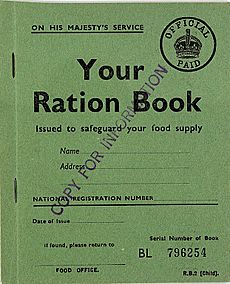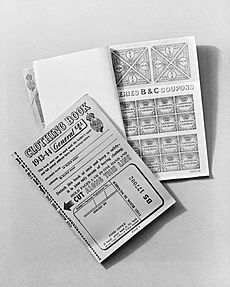Rationing in the United Kingdom facts for kids
Rationing was a system used by the British government during and after wars in the 20th century. It meant that people could only buy a limited amount of certain foods and other goods. This was done to make sure everyone got a fair share, especially when supplies were low.
When World War II started in 1939, Britain imported most of its food. About 70% of its cheese and sugar came from other countries. Almost 80% of fruit and 70% of cereals and fats were imported. More than half of the meat also came from abroad. Germany tried to stop ships bringing food to Britain. This was part of the Battle of the Atlantic. They hoped to starve the country into giving up.
To handle these shortages, the Ministry of Food started rationing. To buy most rationed items, people had to register at specific shops. They received a ration book with coupons. When shopping, people showed their ration books. The shopkeeper would cancel the coupons for the items bought. Rationed items still had to be paid for. Their prices were controlled by the government. Many essential foods were even made cheaper with government help. Rationing limited how much people could buy. Items not rationed could still be hard to find. Prices for some unrationed items were too high for most people.
During World War II, rationing was part of a bigger plan. This plan included controlling prices and helping people afford food. The goal was to manage shortages. It also made sure the armed forces and important services got what they needed. The government wanted everyone to have enough affordable, good quality goods.
Contents
Rationing in the First World War (1914–1918)
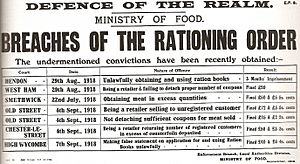
At first, the government didn't want to control food markets during the First World War. They wanted to keep things "business as usual". But in 1916, they made it illegal to eat too many courses in restaurants. People were also fined for feeding pigeons or stray animals.
In January 1917, Germany started attacking ships without warning. This was to try and starve Britain. So, in February 1917, people were asked to ration food voluntarily. Bread was made cheaper later that year. By December 1917, Britain had only six weeks of wheat left. So, the government started making rationing compulsory.
Ration books were introduced in July 1918. These were for butter, margarine, lard, meat, and sugar. Each person was linked to a specific shop. The basic ration provided about 1,680 calories. This was changed for vegetarians, children, and people doing hard work. Local councils also set up food programs for new mothers and young children. Unlike most of Europe, bread was not rationed. Some people believed that people's health actually improved because of rationing. This was because everyone got a fairer share of food. Controls on food were not fully lifted until 1921.
General Strike of 1926
The government got ready to ration food in 1925. This was because they expected a general strike. They even appointed Food Control Officers for each area. However, the strike didn't cause major food shortages. So, these rationing plans were not put into action.
Rationing in the Second World War (1939–1945)
Food Rationing
Before World War II began, 50 million ration books were already printed. Emergency food supplies were also sent to places where people might be evacuated.
When the war started in September 1939, petrol was the first thing to be rationed. On January 8, 1940, bacon, butter, and sugar were rationed. Later, meat, tea, jam, biscuits, breakfast cereals, cheese, eggs, lard, milk, and canned and dried fruit were also rationed. By August 1942, almost all foods were rationed. Only fresh vegetables and bread were not. Strict rationing led to a black market. This is where people bought and sold rationed goods illegally. Most items were rationed by weight. But meat was rationed by how much it cost.
Fruits and Vegetables

Fresh vegetables and fruit were not rationed. However, they were hard to find. Some imported fruits, like lemons and bananas, almost disappeared. Oranges were still sold, but shopkeepers often saved them for children and pregnant women. Apples were sometimes available.
Many people started growing their own vegetables. This was encouraged by the "Dig for Victory" campaign. In 1942, many young children had never seen a banana. They didn't believe they were real! A popular song from before the war, "Yes! We Have No Bananas", became popular again.
Game Meat
Game meat, like rabbit and pigeon, was not rationed. Some scientists even ate laboratory rats to see if they were edible.
Bread
Bread was not rationed until after the war. However, the "national loaf" of wholemeal bread replaced white bread. People found it mushy and grey. They often blamed it for digestion problems. Only four types of bread were allowed. Slicing and wrapping bread was not permitted. In May 1942, new rules were made for restaurants. Meals could not cost more than five shillings. They could not have more than three courses. Only one course could contain meat, fish, or poultry. This was to stop rich people from eating out often to get extra food.
Fish
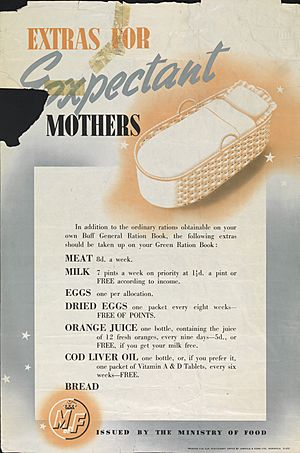
Fish was not rationed, but its price went up a lot. Fishermen faced dangers from enemy attacks and mines. So, they needed to be paid more. Prices were controlled from 1941. Like other foods, fish was rarely plentiful. The Royal Navy took many fishing boats for military use. This left fewer boats to catch fish. Fish supplies dropped to only 30% of what they were before the war. Fish and chips often tasted worse because of the low-quality fat used for frying.
Honey
Beekeeping was very important for farming and industry. So, beekeepers were given extra sugar for their beehives. In 1943, the Ministry of Food announced that beekeepers could get sugar. This was to help their bees survive winter and spring. Honey was not rationed, but its price was controlled. Sellers often limited how much people could buy.
Fuel
On March 13, 1942, the basic petrol ration for cars was stopped. This started on July 1. From then on, petrol was only for official users. This included emergency services, bus companies, and farmers. The armed forces always got priority for fuel. Fuel for approved users was dyed. Using this fuel for non-essential things was against the law.
Subsidies
Besides rationing and price controls, the government also made food fair for everyone. They did this by helping to pay for certain foods. These were items often eaten by poorer people. In 1942–43, £145 million was spent on making food cheaper. This included money for bread, flour, oatmeal, meat, potatoes, milk, and eggs.
Restaurants
At first, restaurants didn't have to follow rationing rules. But people felt this was unfair. Richer people could eat out often to get more food. In May 1942, the Ministry of Food put new rules on restaurants:
- Meals were limited to three courses. Only one course could have fish, game, or poultry.
- No meals could be served between 11:00 p.m. and 5:00 a.m. without a special permit.
- The most a meal could cost was 5 shillings (about £0.25 in 1942). Extra charges were allowed for shows or luxury hotels.
Public Catering
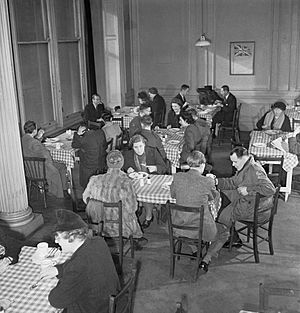
About 2,000 new places called British Restaurants were opened. Local councils ran them in schools and church halls. A simple three-course meal cost only 9d (about £0.0375 in 1942). No ration coupons were needed. These restaurants started to feed people whose homes were bombed. They were open to everyone, especially office and factory workers.
Cooking centers were set up in cities like Sheffield and Plymouth. They provided roast dinners, stew, and pudding. Hot sweet tea was often given out after bombing raids.
Health Effects
In December 1939, two scientists, Elsie Widdowson and Robert McCance, did an experiment. They wanted to see if Britain could survive on only home-grown food if imports stopped. They and other volunteers ate a very strict diet for three months. They had one egg, about 450 grams of meat, and 110 grams of fish a week. They also had about 110 ml of milk a day and 110 grams of margarine. They could eat as many potatoes, vegetables, and wholemeal bread as they wanted. They also did a lot of exercise.
The scientists found that everyone stayed healthy and strong. The only issues were needing more time to eat enough calories from bread and potatoes. The results of this study were kept secret until after the war. They gave the government confidence that food could be shared equally. This meant important war workers would stay healthy. Britain's actual wartime diet was never as strict. This was because food still came from the United States. Rationing actually made British people healthier. Baby deaths went down, and people lived longer. This was because rationing made sure everyone got a good mix of foods and enough vitamins. Blackcurrant syrup and later American orange juice were given free to young children. Pregnant mothers and children also got cheaper milk. People ate less fat and sugar but more milk and fiber.
Standard Food Rationing During the Second World War
Here are the typical weekly rations during the Second World War:
| Item | Maximum level | Minimum level | April 1945 |
|---|---|---|---|
| Bacon and ham | 8 oz (227 g) | 4 oz (113 g) | 4 oz (113 g) |
| Sugar | 16 oz (454 g) | 8 oz (227 g) | 8 oz (227 g) |
| Loose tea | 4 oz (113 g) | 2 oz (57 g) | 2 oz (57 g) |
| Meat | 1 s. 2d. | 1s | 1s. 2d. (equivalent to £1.8 in 2021 ) |
| Cheese | 8 oz (227 g) | 1 oz (28 g) | 2 oz (57 g)
Vegetarians were allowed an extra 3 oz (85 g) cheese |
| Preserves | 1 lb (0.45 kg) per month 2 lb (0.91 kg) marmalade |
8 oz (227 g) per month | 2 lb (0.91 kg) marmalade or 1 lb (0.45 kg) preserve or 1 lb (0.45 kg) sugar |
| Butter | 8 oz (227 g) | 2 oz (57 g) | 2 oz (57 g) |
| Margarine | 12 oz (340 g) | 4 oz (113 g) | 4 oz (113 g) |
| Lard | 3 oz (85 g) | 2 oz (57 g) | 2 oz (57 g) |
| Sweets | 16 oz (454 g) per month | 8 oz (227 g) per month | 12 oz (340 g) per month |
One shilling and two pence bought about 540 grams of meat. Offal (like liver) and sausages were only rationed from 1942 to 1944. When sausages were not rationed, they often had a lot of bread in them because meat was so scarce. Eggs were rationed. In 1944, people usually got one egg at a time, 30 times a year. Children and some sick people got three eggs a week. Pregnant mothers got two eggs each time they were available.
- People got one egg per week. Or, they could have one packet of egg powder per month (which made 12 fake eggs). Vegetarians were allowed two eggs.
- Plus, people had 24 points every four weeks for canned and dried food.
Vegetarians could swap their meat rations for other goods.
Milk was supplied at about 3 liters each week. Pregnant mothers and children under 5 got priority. Those under 18 got 3.5 liters. Children who couldn't go to school got 5 liters. Some sick people could get up to 14 liters. Everyone also received one tin of milk powder (equal to about 8 liters of milk) every eight weeks.
Special Civilian Rations
Some people got more cheese than the usual 3 ounces a week. They were allowed 8 ounces. This included:
- Vegetarians (they had to give up their meat and bacon coupons)
- Underground mine workers
- Farm workers
- Road workers
- Forestry workers
- Land drainage workers
- Members of the Women's Land Army
- Railway workers (like train crews and signalmen) who didn't have access to canteens
- Certain agricultural workers (like those on threshing machines or tractor workers).
Weekly Supplementary Allowances of Rationed Foods for Invalids
Some people with certain illnesses received extra food. Here are some examples:
| Disease | Food supplementary allowance |
Quantity | Coupons to be surrendered |
|---|---|---|---|
| Diabetes | Butter and margarine | 12 oz (340 g) (not more than 4 oz (110 g) butter) | Sugar |
| Diabetes | Meat | 2s. 4d. adult, 1s. 2d. child under six | Sugar |
| Diabetes – vegetarians only | Cheese | 8 oz (230 g) | Sugar |
| Hypoglycaemia | Sugar | 16 oz (450 g) | – |
| Steatorrhoea | Meat | 4s. 8d. adult, 2s. 4d. child under six | Butter and margarine |
| Nephritis with gross albuminuria and gross oedema, also nephrosis |
Meat | 3s. 6d. adult, 1s. 9d. child under six |
Non-Food Rations
Clothing
As the war went on, rationing included other goods like clothing. People were given points for different clothes.
Raw materials were scarce. Factories were making things for the war, like uniforms. Prices for clothes and fabrics went up. The government needed to make sure everyone could still buy clothes.
Rationing for cloth, clothing, and shoes started on June 1, 1941. It lasted until March 1949. Clothes rationing also aimed to reduce how many new clothes people bought. This meant less clothing was made for civilians.
The public was surprised when clothes rationing was announced. This was to stop people from panic-buying. People had to use coupons and pay cash for clothes, shoes, and fabrics. At first, people used unused margarine coupons from their food ration books. Later, special clothing coupon books were given out. Initially, people got 66 points for clothing each year. This was cut to 48 in 1942, 36 in 1943, and 24 in 1945–1946.
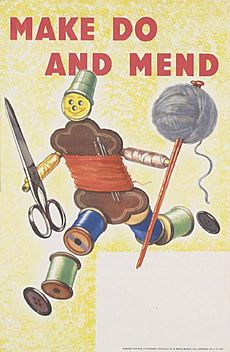
Different clothes needed different numbers of coupons. This depended on how much material and work went into them. For example, an adult's skirt needed seven coupons. A child's pyjamas needed six coupons. Coupons could also be used for wool, cotton, and household textiles. Clothes for children under four years old did not need coupons.
The prices of second-hand clothing and fur coats were fixed. But no coupons were needed to buy them. People got extra coupons for work clothes, like overalls for factory work. Manual workers, people in civilian uniforms, diplomats, performers, and new mothers also got extra coupons.
Clothes of different quality cost different prices but needed the same coupons. Cheaper clothes often wore out faster. So, the government started the Utility Clothing Scheme in September 1941. People were also encouraged to repair and remake old clothes. The Ministry of Information made pamphlets with the slogan "Make Do and Mend" in 1943. These gave ideas and instructions for fixing clothes.
Clothes rationing ended on March 15, 1949.
Soap
All types of soap were rationed. Coupons were given based on weight or quantity (for liquid soap). In 1945, people got four coupons each month. Babies, some workers, and sick people got more. One coupon could buy:
- 4 ounces of hard soap
- 3 ounces of toilet soap
- 0.5 ounces of liquid soap
- 6 ounces of soft soap
- 3 ounces of soap flakes
- 6 ounces of powdered soap
Fuel
The Fuel and Lighting (Coal) Order 1941 started in January 1942. Central heating was not allowed in summer. Home coal was rationed to about 760 kg for people in London and southern England. It was about 1,000 kg for the rest of the country. This was because the south had milder weather. Some coal, like anthracite, was not rationed. In coal-mining areas, people eagerly collected waste coal.
Petrol
Petrol rationing started in September 1939. People could drive about 320 km per month. The coupons depended on the car's RAC horsepower and how much fuel it usually used. From July 1942 to June 1945, the basic ration was completely stopped. Only people with official permission got fuel. In June 1945, the basic ration was brought back. It allowed about 240 km per month. This increased to about 290 km per month in August 1945.
Paper
Newspapers were limited from September 1939. At first, they could only use 60% of the paper they used before the war. Paper supply was controlled by the Ministry of Production. By 1945, newspapers were limited to 25% of their pre-war paper use. Wrapping paper for most goods was not allowed.
The paper shortage made it hard for authors to get their books published. In 1944, George Orwell wrote about how little paper was given for books. The War Office got more paper than the entire book industry. This meant many classic books were out of print. Schools didn't have enough textbooks. New writers found it hard to get started. Even famous writers had to wait a year or two for their books to be published.
Other Products
Many personal items were hard to find, whether they were rationed or not. This was because parts for them were scarce. Examples included razor blades, baby bottles, alarm clocks, frying pans, and pots. Balloons and sugar for birthday cakes were partly or completely unavailable. Couples had to use fake cardboard and plaster wedding cakes. A smaller real cake was hidden inside. Houseplants were impossible to get, so people used carrot tops instead. Many fathers saved bits of wood to make toys for Christmas. Christmas trees were almost impossible to find because timber was rationed.
After the Second World War (1945–1954)
World War II ended in Europe on May 8, 1945. But rationing continued for several years. Some rationing even became stricter than during the war. Bread was rationed from July 21, 1946, to July 24, 1948. People's average body weight went down. They ate more potatoes. Some unusual foods, like whale meat and canned snoek fish, were not rationed. But they were not popular. In 1950, 4,000 tonnes of whale meat were not sold. When sweets were taken off ration in April 1949, people rushed to sweet shops. So, rationing had to be brought back in August and lasted until 1953.
The government said rationing was needed to feed people in war-torn Europe. This was partly true. But many British men were still in the armed forces. The economy was struggling. American help was reduced. So, there weren't enough resources to produce or import more food. Strikes by workers, especially dock workers, made things worse. A common trick was for people to use the ration books of dead relatives.
Political Reaction
In the late 1940s, the Conservative Party used public anger about rationing to gain support. They promised to end shortages and government controls. This helped them win the 1951 United Kingdom general election. Their message was especially popular with housewives. They faced even harder shopping conditions after the war than during it.
Timeline

1945
- May 27: Bacon ration cut from 110 grams to 85 grams per week. Cooking fat ration cut from 55 grams to 28 grams per week. Soap ration cut by one-eighth.
- June 1: The basic petrol ration for civilians was brought back.
- July 19: To keep rationing fair, gift food parcels from other countries weighing more than 2.3 kg would reduce the recipient's ration.
1946
- Summer: Heavy rain ruined Britain's wheat crop. Bread and flour rationing began.
1947
- January–March: A very cold winter. Frost destroyed many stored potatoes. Potato rationing began.
- Mid-year: A transport and dock strike caused imported meat to rot. The Army had to step in. The basic petrol ration was stopped again.
1948
- June 1: A new law was passed. It ordered red dye to be put into some petrol. This "red petrol" could only be used in commercial vehicles. A private car driver could lose their license for a year if caught with red petrol. Petrol stations could be shut down for selling it to private drivers.
- June: The basic petrol ration was brought back. But it only allowed about 145 km per month.
- Bread came off ration.
1949
- May: Clothes rationing ended. This was partly because many people were illegally trading coupons or stealing ration books.
- June, July, and August: The basic petrol ration was temporarily increased to allow about 290 km per month.
1950
- February 23: The 1950 United Kingdom general election was largely about rationing. The Conservative Party wanted to end rationing quickly. The Labour Party wanted to continue it. Labour won, but with a much smaller majority.
- March: The Ministry of Fuel and Power announced that the petrol ration would be doubled for June, July, and August.
- April: The Ministry of Fuel and Power announced that the petrol ration would be doubled for 12 months starting June 1.
- May 26: Petrol rationing ended.
1951
- October 25: The 1951 United Kingdom general election took place. The Conservatives returned to power.
1953
- February 4: Sweets and chocolate rationing ended.
- September: Sugar rationing ended.
1954
- July 4: Meat and all other food rationing ended in Britain.
Even after rationing ended in 1954, cheese production was affected for decades. During rationing, most milk in Britain was used to make one type of cheese, called Government Cheddar. This almost stopped the production of other British cheeses. Government controls on milk prices continued to discourage other cheese varieties until the 1980s. It was only in the mid-1990s that the British cheese industry started to grow again.
1958
- Coal rationing ended in July.
Suez Crisis (1956–1957)
During the Suez Crisis, petrol rationing was briefly brought back. It lasted from December 17, 1956, to May 14, 1957. Advertising petrol on the new ITV channel was banned for a while.
Oil Crises of 1973 and 1979
Petrol coupons were printed in case of rationing during the 1973 oil crisis. But rationing never happened. This was largely because Britain started producing more North Sea oil. By the time of the 1979 energy crisis, the UK was exporting oil. So, the government didn't even consider petrol rationing then.
See also
- British cuisine
- List of renewable resources produced and traded by the United Kingdom
- Ration stamp
- Spiv
- Utility clothing
- Utility furniture
- Woolton pie
- Rationing in the United Kingdom § Notes



